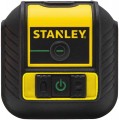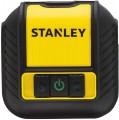Accuracy
Accuracy is described as the maximum deviation from the true value of the measured parameter, which the device can give if all the rules for its operation and the corresponding measurements are observed. In both rangefinders and levels, this parameter is usually designated for a certain distance — for example, 3 mm at 30 m; but even for one manufacturer, these "control" distances may be different. Therefore, in our catalog, the accuracy of all devices is recalculated for 1 m distance; with such a record, for the example above, it will be 3/30 \u003d 0.1 mm / m. This makes it easier to compare different models with each other.
It is also worth mentioning that the meaning of the "accuracy" parameter for different types of measuring instruments (see "Type") will be different. For optical levels, it is described in the "SKP" paragraph above. For laser levels of all types, accuracy is the maximum deviation of the mark from the true horizontal (or vertical, if such a function is provided), and for the horizontal, we can talk about both moving the mark up / down and turning it. In rangefinders, this characteristic describes the maximum difference (both in "plus" and "minus") between the readings of the device and the actual distance to the object.
Anyway, the smaller the error, the better; on the other hand, accuracy significantly affects the price of the device. Therefore, it is necessary to choose a specific model for this parameter, taking into account the...specifics of the planned work. For example, for a relatively simple repair in a residential apartment, a high-precision tool is unlikely to be required; and recommendations for more complex tasks can be found in specialized sources, ranging from expert advice to official instructions.
Leveling time
Approximate time it takes for the self-levelling mechanism to bring the level to a perfectly level position.
For more information on such a mechanism, see Self-Level Limits. And the actual time of its alignment directly depends on the actual deviation of the device from the horizontal. Therefore, in the characteristics, usually, the maximum alignment time is given — that is, for the situation when in the initial position the device is tilted to the maximum angle along both axes, longitudinal and transverse. Since the levels are far from being installed in this position, in fact the speed of bringing to the horizontal is often higher than the claimed one. Nevertheless, it makes sense to evaluate different models precisely according to the figures stated in the characteristics — they allow you to estimate the maximum amount of time that will have to be spent on alignment after the next movement of the device. As for specific indicators, they can vary from 1.5 – 2 s to 30 s.
Theoretically, the shorter the alignment time, the better, especially if there are large volumes of work ahead with frequent movements from place to place. However, in fact, when comparing different models, it is worth considering other points. First, we reiterate that the rate of leveling is highly dependent on the leveling limits; after all, the greater the deviation angles, the more time it usually takes for the mechanism to return the level to the horizontal. So, to directly compare w...ith each other in terms of the speed of self-leveling, it is mainly those devices in which the permissible deviation angles are the same or differ slightly. Secondly, when choosing, it is worth considering the specifics of the proposed work. So, if the device is to be used frequently on very uneven surfaces, then, for example, a model with a leveling time of 20 s and self-levelling limits of 6 ° will be a more reasonable choice than a device with a time of 5 s and limits of 2 °, since in In the second case, a lot of time will be spent on the initial (manual) installation of the device. And for more or less even horizontal planes, on the contrary, a faster device may be the best option.
Diode emission
The wavelength of the radiation emitted by the LED of the level or rangefinder; this parameter determines primarily the colour of the laser beam. The most widespread in modern models are LEDs with a wavelength of about 635 nm — at a relatively low cost, they provide bright red radiation, giving a well-visible projection. There are also green lasers, usually at 532 nm — the marks from them are even better visible, but such LEDs are quite expensive and rarely used. And radiation with a wave longer than 780 nm belongs to the infrared spectrum. Such a laser is invisible to the naked eye and is poorly suited for leveling, but it can be used in rangefinders — of course, with a viewfinder (see "Type" for more details).
Beam angle (vertical)
The sweep angle in the vertical plane provided by the level emitter. If there are several such radiators (for example, on both sides of the case), this parameter is given for each of them separately.
The sweep angle is, in fact, the coverage angle, that is, the width of the sector captured by the emitter when the line is formed. The wider this angle, the more convenient the device is to use, the lower the likelihood that the device will have to be moved up and down to build a line. On the other hand, a larger sweep angle (at the same range) requires more power — and this, accordingly, affects the cost and power consumption.
Beam angle (horizontal)
The sweep angle in the horizontal plane provided by the level emitter. If there are several emitters, their total coverage angle is indicated here; a typical example of such devices are models for full 360 °, not related to rotation.
Actually, all rotary devices, by definition, provide a coverage of 360 °. Therefore, it is worth paying attention to this parameter in cases where we are talking about more traditional laser levels. And here it is worth considering that a larger coverage angle, on the one hand, can provide additional convenience, on the other hand, it increases the price and power consumption of the device. So when choosing, you should proceed from real needs; detailed recommendations on this subject can be found in special sources.
Operating time
Operating time of the device on one battery charge.
It is worth considering that these figures are quite approximate, since the operating time is measured under certain standard conditions (usually continuous operation at nominal power). And since in practice conditions may differ markedly, the operating time may turn out to be noticeably shorter or longer than stated. In addition, if the device uses replaceable batteries (AAA, AA and the like), then autonomy will also depend on the quality of the specific batteries/accumulators. Nevertheless, based on the data specified in the characteristics, it is quite possible to evaluate the capabilities of specific models and compare them with each other: the difference in the declared operating time, as a rule, proportionally corresponds to the difference in practical autonomy under the same conditions.
We also note that the operating time is specified mainly for levels; in rangefinders another parameter is more often used - the number of measurements (see below).

